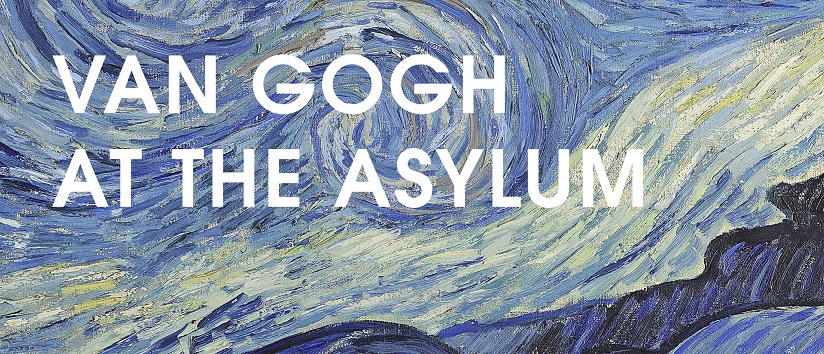Priests, peasants and prolific creativity: Van Gogh's year as a mental health patient
04 September 2018
The renowned artist Vincent Van Gogh’s died by suicide in 1890, two months after leaving a mental asylum. Martin Bailey researched his year in the institution.
Writing a book on Van Gogh’s year in a mental asylum brought me much closer to understanding how difficult life must have been for the artist - and how he overcame the challenges. Starry Night: Van Gogh at the Asylum investigates his stay at Saint-Paul-de-Mausole, an institution that was not far from Arles, in Provence.
"The picture captures the artist’s recollections of the night sky viewed through the bars of his bedroom window - and then filtered and interpreted through his creative vision."
Van Gogh had left Paris in February 1888 and headed for the south of France, in order to lead a more tranquil life and develop as a landscape painter. After renting the Yellow House, which was near the railway station in Arles, he had space to invite a fellow artist to join him to create what he called the “Studio in the South”. Paul Gauguin came in the autumn and for two months they worked together. Then, just before Christmas, came the terrible incident when Van Gogh mutilated his ear. Although the physical wound healed quickly, Van Gogh realised that he could not manage to live independently, and after a stay in hospital he moved to Saint-Paul in May 1889.
New insights
Although biographers of Van Gogh rely very heavily on the artist’s letters, I was determined to dig deeper, and look for other sources. Among the discoveries was an unpublished admission register, identifying most of the other 18 male patients who were there when the artist arrived. I then cross-referenced the register material with a 1920s article by the asylum director, Edgar Leroy, who described the medical conditions of many of the men. Uncovering their stories helped provide the context for understanding Van Gogh’s stay. These were the men he would encounter at most hours of the day - in the refectory, the common room and the walled garden.
- See also: What is bipolar disorder?
- See also: Creativity as therapy
For most of his year-long stay Van Gogh was 'mentally alert' and in much better shape than nearly all his fellow patients. The men ranged in age from 20 to 77 and had very different backgrounds - ranging from peasants to priests. Many of the patients had severe mental health conditions, found it difficult to communicate and social interaction would have been limited.
Escapism
It must also have been very difficult for Van Gogh to adjust to institutional life, after the freedom he had enjoyed in the Yellow House. Art offered him a means of escape, an opportunity to try to forget his environment and move into the world of his visual imagination. This was the key point that emerged during my study of his asylum year.
Unlike his companions, Van Gogh had a vocation, and spent most of his waking hours at his easel. He worked in the cell that was allocated to him as a studio, in the garden and, when in reasonable health, just outside the asylum in the olive groves and amongst the cypresses. But sadly he suffered four serious episodes, which incapacitated him for a quarter of his time at the asylum.
In Van Gogh’s time little was known about mental disorders and even less about their treatment. His own doctors diagnosed epilepsy, but little could be done about it. At the hospital in Arles he had been given potassium bromide, a sedative which reduces hallucinations (but which is no longer prescribed because of its toxicity). This may well also have been prescribed at Saint-Paul. But the main form of “treatment” was baths, which were believed to be beneficial.
Since Van Gogh’s suicide in 1890, two months after leaving the asylum, hundreds of medical specialists have published papers suggesting possible diagnoses. As mentioned above, Van Gogh’s own doctors diagnosed epilepsy, which was then believed to be the cause of many mental health problems. Today bipolar disorder seems the most likely diagnosis, since this might account for the changes in his condition and the series of mental health episodes he suffered. But bipolar disorder is far from certain, and specialists have also credibly suggested cycloid psychosis or borderline personality disorder.
A symposium on the artist’s medical condition, held at the Van Gogh Museum in September 2016, brought together leading international specialists, but they reached little agreement. A promised report on the symposium has still not been published. Although a complete non-specialist in the medical field, I have always suspected that he suffered from more than a single condition, and that one of these was probably hereditary. Vincent’s youngest brother committed suicide and one of his sisters spent the last forty years in a mental hospital. [Editor's note - there is no consensus among mental health experts around whether mental health conditions can be inherited.]
But considering Vincent’s problems, the astonishing thing is his productivity in the difficult environment of a mental asylum. Just over 150 paintings survive from his year at Saint-Paul and some have been lost. So, when in reasonable health, he completed a painting every day and a half.
Among his masterpieces is Starry Night, now at New York’s Museum of Modern Art. The landscape section of the painting with the houses and towering church was loosely inspired by the nearby village of Saint-Rémy-de-Provence. But it is the sky that is so memorable, with its swirling cloud-like form, hurtling towards a bright yellow crescent moon. The picture captures the artist’s recollections of the night sky viewed through the bars of his bedroom window - and then filtered and interpreted through his creative vision.
Starry Night is emblematic of Van Gogh’s time at the asylum. He suffered a series of crises which thrust him into a darkness, but each time he recovered and reemerged from the depths of despair. He would return into the light, once again taking up his brush. Starry Night represents a vibrant testament to the artist’s struggle to overcome the challenges - an inspiration to us all.
Martin Bailey is the author of Starry Night: Van Gogh at the Asylum, White Lion Publishing, £25, available from Amazon.


Comments
Write a Comment
Comment Submitted